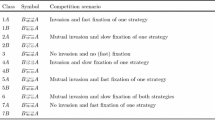Abstract
We introduce a model of stochastic evolutionary game dynamics in finite populations which is similar to the familiar replicator dynamics for infinite populations. Our focus is on the conditions for selection favoring the invasion and/or fixation of new phenotypes. For infinite populations, there are three generic selection scenarios describing evolutionary game dynamics among two strategies. For finite populations, there are eight selection scenarios. For a fixed payoff matrix a number of these scenarios can occur for different population sizes. We discuss several examples with unexpected behavior.
Similar content being viewed by others
References
Benaim, M., S. Schreiber and P. Tarres (2003). Generalized urn models of evolutionary processes. Ann. Appl. Prob. (in press).
Ficici, S. and J. Pollack (2000). Effects of finite populations on evolutionary stable strategies, in Proceedings of the 2000 Genetic and Evolutionary Computation Conference, L. Darrell Whitley (Ed.), Morgan-Kaufmann.
Fogel, G., P. Andrews and D. Fogel (1998). On the instability of evolutionary stable strategies in small populations. Ecol. Modeling 109, 283–294; Biosystems 44, 135–152.
Fogel, D., G. Fogel and P. Andrews (1997). On the instability of evolutionary stable strategies. Biosystems 44, 135–152.
Foster, D. and P. Young (1990). Stochastic evolutionary game dynamics. Theor. Popul. Biol. 38, 219–232; (1997). Theor. Popul. Biol. 51, 77–78 Corrigendum.
Fudenberg, D. and C. Harris (1992). Evolutionary dynamics with aggregate shocks. J. Econom. Theory 57, 420–441.
Fudenberg, D., M. Nowak and C. Taylor (2003). Stochastic evolution in finite populations. Games Econ. Behav. (submitted for publication).
Hamilton, W. D. (1971). Selection of selfish and altruistic behavior in some extreme models, in Man and Beast: Comparative Social Behavior, J. F. Eisenberg and W. S. Dillon (Eds), Washington, DC: Smithsonian Institution.
Hofbauer, J., P. Schuster and K. Sigmund (1979). A note on evolutionary stable strategies and game dynamics. J. Theor. Biol. 81, 609–612.
Hofbauer, J. and K. Sigmund (1998). Evolutionary Games and Population Dynamics, Cambridge University Press.
Hofbauer, J. and K. Sigmund (2003). Evolutionary game dynamics. Bull. Am. Math. Soc. 40, 479–519.
Kandori, M., G. Mailath and R. Rob (1993). Learning, mutation, and long run equilibria in games. Econometrica 61, 29–56.
Karlin, S. and H. Taylor (1975). A First Course in Stochastic Processes, Academic Press.
Maruyama, T. and M. Nei (1981). Genetic variability maintained by mutation and overdominant selection in finite populations. Genetics 98, 441–459.
Maynard Smith, J. (1982). Evolution and the Theory of Games, Cambridge University Press.
Maynard Smith, J. (1988). Can a mixed strategy be stable in a finite population? J. Theor. Biol. 130, 247–251.
Moran, P. A. P. (1962). The Statistical Processes of Evolutionary Theory, Oxford: Clarendon Press.
Nowak, M. A., A. Sasaki, C. Taylor and D. Fudenberg (2003). Emergence of cooperation and evolutionary stability in finite populations. Nature 248, 646–650.
Sasaki, A. (1989). Evolution of pathogen strategies. PhD thesis, Kyushu University.
Sasaki, A. (1992). The evolution of host and pathogen genes under epidemiological interaction. Population Pareo-Genetics, in Proceeding of the Seventeenth Taniguchi International Symposium on Biophysics, N. Takahata (Ed.), Tokyo: Japan Scientific Society Press, pp. 247–263.
Schaffer, M. (1988). Evolutionary stable strategies for a finite population and a variable contest size. J. Theor. Biol. 132, 469–478.
Schreiber, S. (2001). Urn models, replicator processes, and random genetic drift. SIAM J. Appl. Math. 61, 2148–2167.
Slatkin, M. (2000). Balancing selection at closely linked, overdominant loci in a finite population. Genetics 154, 1367–1378.
Takahata, N. and M. Nei (1990). Frequency-dependent selection and polymorphism of major histocompatibility complex loci. Genetics 124, 967–978.
Taylor, P. D. and L. Jonker (1978). Evolutionary stable strategies and game dynamics. Math. Biosci. 40, 145–156.
Young, P. (1993). The evolution of conventions. Econometrica 61, 57–84.
Author information
Authors and Affiliations
Corresponding author
Rights and permissions
About this article
Cite this article
Taylor, C., Fudenberg, D., Sasaki, A. et al. Evolutionary game dynamics in finite populations. Bull. Math. Biol. 66, 1621–1644 (2004). https://doi.org/10.1016/j.bulm.2004.03.004
Received:
Accepted:
Issue Date:
DOI: https://doi.org/10.1016/j.bulm.2004.03.004




